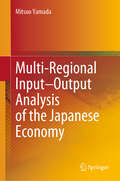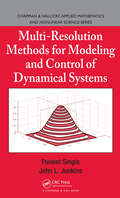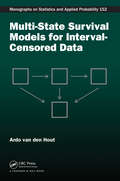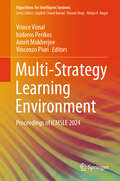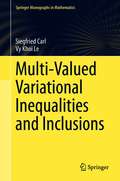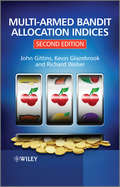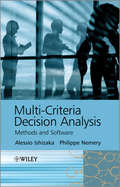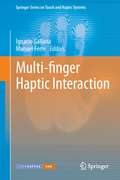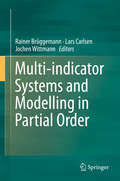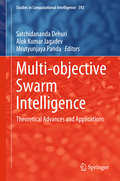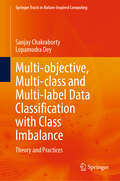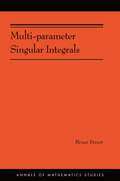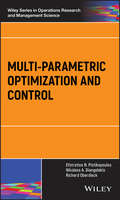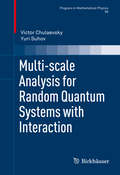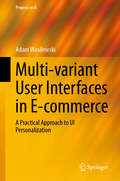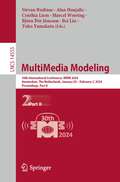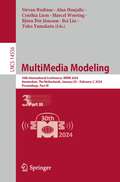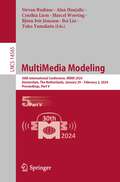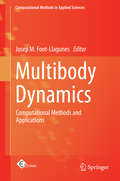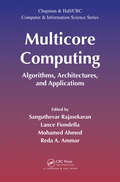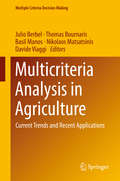- Table View
- List View
Multi-Regional Input–Output Analysis of the Japanese Economy
by Mitsuo YamadaThis book presents multi-regional input-output tables from the prefectural level as well as non-survey methods for creating the tables that divide a prefecture into sub-regions—into municipalities, for instance. In this book, the reader will find a survey of Japan's multilayered input–output tables and the research employing them, with an explanation of how to compile and apply a multi-regional input–output table for the country’s economy. Also included is research on currently important topics in municipal economies, carried out by municipality-based input–output analysis. Many input–output tables already have been compiled for each of the 47 prefectures of Japan as well as for major municipalities such as ordinance-designated cities, i.e., with populations greater than 500,000. The input–output table, or “benchmark table”, for the entire country, which is jointly compiled by 10 ministries and agencies including the Ministry of Internal Affairs and Communications, provides the essential information for the compilation of regional input-output tables. In recent years, there has been a great deal of interest in the estimation of municipality-based input–output tables to help provide perspective for regional economic revitalization and evidence-based policymaking. This book, with its information on how to create and apply multiregional input–output tables, is useful for graduate students, researchers, and local government officials who are concerned with this field.
Multi-Resolution Methods for Modeling and Control of Dynamical Systems (Chapman & Hall/CRC Applied Mathematics & Nonlinear Science)
by Puneet Singla John L. JunkinsUnifying the most important methodology in this field, Multi-Resolution Methods for Modeling and Control of Dynamical Systems explores existing approximation methods as well as develops new ones for the approximate solution of large-scale dynamical system problems. It brings together a wide set of material from classical orthogonal function
Multi-State Survival Models for Interval-Censored Data (Chapman & Hall/CRC Monographs on Statistics and Applied Probability)
by Ardo van den HoutMulti-State Survival Models for Interval-Censored Data introduces methods to describe stochastic processes that consist of transitions between states over time. It is targeted at researchers in medical statistics, epidemiology, demography, and social statistics. One of the applications in the book is a three-state process for dementia and survival in the older population. This process is described by an illness-death model with a dementia-free state, a dementia state, and a dead state. Statistical modelling of a multi-state process can investigate potential associations between the risk of moving to the next state and variables such as age, gender, or education. A model can also be used to predict the multi-state process. The methods are for longitudinal data subject to interval censoring. Depending on the definition of a state, it is possible that the time of the transition into a state is not observed exactly. However, when longitudinal data are available the transition time may be known to lie in the time interval defined by two successive observations. Such an interval-censored observation scheme can be taken into account in the statistical inference. Multi-state modelling is an elegant combination of statistical inference and the theory of stochastic processes. Multi-State Survival Models for Interval-Censored Data shows that the statistical modelling is versatile and allows for a wide range of applications.
Multi-Strategy Learning Environment: Proceedings of ICMSLE 2024 (Algorithms for Intelligent Systems)
by Vincenzo Piuri Isidoros Perikos Vrince Vimal Amrit MukherjeeThe book presents selected papers from International Conference on Multi-Strategy Learning Environment (ICMSLE 2024), held at Graphic Era Hill University, Dehradun, India, during 12–13 January 2024. This book presents current research in machine learning techniques, deep learning theories and practices, interpretability and explainability of AI algorithms, game theory and learning, multi-strategy learning (MSL) in distributed and streaming environments, and adaptive data analysis and selective inference.
Multi-Valued Variational Inequalities and Inclusions (Springer Monographs in Mathematics)
by Siegfried Carl Vy Khoi LeThis book focuses on a large class of multi-valued variational differential inequalities and inclusions of stationary and evolutionary types with constraints reflected by subdifferentials of convex functionals. Its main goal is to provide a systematic, unified, and relatively self-contained exposition of existence, comparison and enclosure principles, together with other qualitative properties of multi-valued variational inequalities and inclusions. The problems under consideration are studied in different function spaces such as Sobolev spaces, Orlicz-Sobolev spaces, Sobolev spaces with variable exponents, and Beppo-Levi spaces. A general and comprehensive sub-supersolution method (lattice method) is developed for both stationary and evolutionary multi-valued variational inequalities, which preserves the characteristic features of the commonly known sub-supersolution method for single-valued, quasilinear elliptic and parabolic problems. This method provides a powerful tool for studying existence and enclosure properties of solutions when the coercivity of the problems under consideration fails. It can also be used to investigate qualitative properties such as the multiplicity and location of solutions or the existence of extremal solutions. This is the first in-depth treatise on the sub-supersolution (lattice) method for multi-valued variational inequalities without any variational structures, together with related topics. The choice of the included materials and their organization in the book also makes it useful and accessible to a large audience consisting of graduate students and researchers in various areas of Mathematical Analysis and Theoretical Physics.
Multi-armed Bandit Allocation Indices
by John Gittins Richard Weber Kevin GlazebrookIn 1989 the first edition of this book set out Gittins' pioneering index solution to the multi-armed bandit problem and his subsequent investigation of a wide of sequential resource allocation and stochastic scheduling problems. Since then there has been a remarkable flowering of new insights, generalizations and applications, to which Glazebrook and Weber have made major contributions.This second edition brings the story up to date. There are new chapters on the achievable region approach to stochastic optimization problems, the construction of performance bounds for suboptimal policies, Whittle's restless bandits, and the use of Lagrangian relaxation in the construction and evaluation of index policies. Some of the many varied proofs of the index theorem are discussed along with the insights that they provide. Many contemporary applications are surveyed, and over 150 new references are included.Over the past 40 years the Gittins index has helped theoreticians and practitioners to address a huge variety of problems within chemometrics, economics, engineering, numerical analysis, operational research, probability, statistics and website design. This new edition will be an important resource for others wishing to use this approach.
Multi-criteria Decision Analysis
by Philippe Nemery Alessio IshizakaThis book presents an introduction to MCDA followed by more detailed chapters about each of the leading methods used in this field. Comparison of methods and software is also featured to enable readers to choose the most appropriate method needed in their research.Worked examples as well as the software featured in the book are available on an accompanying website.
Multi-fidelity Surrogates: Modeling, Optimization and Applications (Engineering Applications of Computational Methods #12)
by Qi Zhou Min Zhao Jiexiang Hu Mengying MaThis book investigates two types of static multi-fidelity surrogates modeling approaches, sequential multi-fidelity surrogates modeling approaches, the multi-fidelity surrogates-assisted efficient global optimization, reliability analysis, robust design optimization, and evolutionary optimization. Multi-fidelity surrogates have attracted a significant amount of attention in simulation-based design and optimization in recent years. Some real-life engineering design problems, such as prediction of angular distortion in the laser welding, optimization design of micro-aerial vehicle fuselage, and optimization design of metamaterial vibration isolator, are also provided to illustrate the ability and merits of multi-fidelity surrogates in support of engineering design. Specifically, lots of illustrative examples are adopted throughout the book to help explain the approaches in a more “hands-on” manner. This book is a useful reference for postgraduates and researchers of mechanical engineering, as well as engineers of enterprises in related fields.
Multi-finger Haptic Interaction
by Manuel Ferre Ignacio GalianaMulti-finger Haptic Interaction presents a panorama of technologies and methods for multi-finger haptic interaction, together with an analysis of the benefits and implications of adding multiple-fingers to haptic applications. Research topics covered include: design and control of advanced haptic devices;multi-contact point simulation algorithms;interaction techniques and implications in human perception when interacting with multiple fingers.These multi-disciplinary results are integrated into applications such as medical simulators for training manual skills, simulators for virtual prototyping and precise manipulations in remote environments. Multi-finger Haptic Interaction presents the current and potential applications that can be developed with these systems, and details the systems' complexity. The research is focused on enhancing haptic interaction by providing multiple contact points to the user. This state-of-the-art volume is oriented towards researchers who are involved in haptic device design, rendering methods and perception studies, as well as readers from different disciplines who are interested in applying multi-finger haptic technologies and methods to their field of interest.
Multi-indicator Systems and Modelling in Partial Order
by Rainer Brüggemann Lars Carlsen Jochen Wittmann"Multi-indicator Systems and Modelling in Partial Order" contains the newest theoretical concepts as well as new applications or even applications, where standard multivariate statistics fail. Some of the presentations have their counterpart in the book; however, there are many contributions, which are completely new in the field of applied partial order.
Multi-objective Swarm Intelligence
by Satchidananda Dehuri Alok Kumar Jagadev Mrutyunjaya PandaThe aim of this book is to understand the state-of-the-art theoretical and practical advances of swarm intelligence. It comprises seven contemporary relevant chapters. In chapter 1, a review of Bacteria Foraging Optimization (BFO) techniques for both single and multiple criterions problem is presented. A survey on swarm intelligence for multiple and many objectives optimization is presented in chapter 2 along with a topical study on EEG signal analysis. Without compromising the extensive simulation study, a comparative study of variants of MOPSO is provided in chapter 3. Intractable problems like subset and job scheduling problems are discussed in chapters 4 and 7 by different hybrid swarm intelligence techniques. An attempt to study image enhancement by ant colony optimization is made in chapter 5. Finally, chapter 7 covers the aspect of uncertainty in data by hybrid PSO.
Multi-objective, Multi-class and Multi-label Data Classification with Class Imbalance: Theory and Practices (Springer Tracts in Nature-Inspired Computing)
by Sanjay Chakraborty Lopamudra DeyThis book explores intricate world of data classification with 'Multi-Objective, Multi-Class, and Multi-Label Data Classification.' This book studies sophisticated methods and strategies for working with complicated data sets, tackling the difficulties of various classes, many objectives, and complicated labelling tasks. This resource fosters a deeper grasp of multi-dimensional data analysis in today's data-driven world by providing readers with the skills and insights needed to navigate the subtleties of modern classification jobs, from algorithmic techniques to practical applications.
Multi-parameter Singular Integrals. (Annals of Mathematics Studies #189)
by Brian StreetThis book develops a new theory of multi-parameter singular integrals associated with Carnot-Carathéodory balls. Brian Street first details the classical theory of Calderón-Zygmund singular integrals and applications to linear partial differential equations. He then outlines the theory of multi-parameter Carnot-Carathéodory geometry, where the main tool is a quantitative version of the classical theorem of Frobenius. Street then gives several examples of multi-parameter singular integrals arising naturally in various problems. The final chapter of the book develops a general theory of singular integrals that generalizes and unifies these examples. This is one of the first general theories of multi-parameter singular integrals that goes beyond the product theory of singular integrals and their analogs. Multi-parameter Singular Integrals will interest graduate students and researchers working in singular integrals and related fields.
Multi-parametric Optimization and Control (Wiley Series in Operations Research and Management Science)
by Efstratios N. Pistikopoulos Nikolaos A. Diangelakis Richard OberdieckRecent developments in multi-parametric optimization and control Multi-Parametric Optimization and Control provides comprehensive coverage of recent methodological developments for optimal model-based control through parametric optimization. It also shares real-world research applications to support deeper understanding of the material. Researchers and practitioners can use the book as reference. It is also suitable as a primary or a supplementary textbook. Each chapter looks at the theories related to a topic along with a relevant case study. Topic complexity increases gradually as readers progress through the chapters. The first part of the book presents an overview of the state-of-the-art multi-parametric optimization theory and algorithms in multi-parametric programming. The second examines the connection between multi-parametric programming and model-predictive control—from the linear quadratic regulator over hybrid systems to periodic systems and robust control. The third part of the book addresses multi-parametric optimization in process systems engineering. A step-by-step procedure is introduced for embedding the programming within the system engineering, which leads the reader into the topic of the PAROC framework and software platform. PAROC is an integrated framework and platform for the optimization and advanced model-based control of process systems. Uses case studies to illustrate real-world applications for a better understanding of the concepts presented Covers the fundamentals of optimization and model predictive control Provides information on key topics, such as the basic sensitivity theorem, linear programming, quadratic programming, mixed-integer linear programming, optimal control of continuous systems, and multi-parametric optimal control An appendix summarizes the history of multi-parametric optimization algorithms. It also covers the use of the parametric optimization toolbox (POP), which is comprehensive software for efficiently solving multi-parametric programming problems.
Multi-scale Analysis for Random Quantum Systems with Interaction
by Yuri Suhov Victor ChulaevskyThe study of quantum disorder has generated considerable research activity in mathematics and physics over past 40 years. While single-particle models have been extensively studied at a rigorous mathematical level, little was known about systems of several interacting particles, let alone systems with positive spatial particle density. Creating a consistent theory of disorder in multi-particle quantum systems is an important and challenging problem that largely remains open. Multi-scale Analysis for Random Quantum Systems with Interaction presents the progress that had been recently achieved in this area. The main focus of the book is on a rigorous derivation of the multi-particle localization in a strong random external potential field. To make the presentation accessible to a wider audience, the authors restrict attention to a relatively simple tight-binding Anderson model on a cubic lattice Zd. This book includes the following cutting-edge features: an introduction to the state-of-the-art single-particle localization theory an extensive discussion of relevant technical aspects of the localization theory a thorough comparison of the multi-particle model with its single-particle counterpart a self-contained rigorous derivation of both spectral and dynamical localization in the multi-particle tight-binding Anderson model. Required mathematical background for the book includes a knowledge of functional calculus, spectral theory (essentially reduced to the case of finite matrices) and basic probability theory. This is an excellent text for a year-long graduate course or seminar in mathematical physics. It also can serve as a standard reference for specialists.
Multi-scale Simulation of Composite Materials: Results from the Project MuSiKo (Mathematical Engineering)
by Stefan Diebels Sergej RjasanowDue to their high stiffness and strength and their good processing properties short fibre reinforced thermoplastics are well-established construction materials.Up to now, simulation of engineering parts consisting of short fibre reinforced thermoplastics has often been based on macroscopic phenomenological models, but deformations, damage and failure of composite materials strongly depend on their microstructure. The typical modes of failure of short fibre thermoplastics enriched with glass fibres are matrix failure, rupture of fibres and delamination, and pure macroscopic consideration is not sufficient to predict those effects. The typical predictive phenomenological models are complex and only available for very special failures. A quantitative prediction on how failure will change depending on the content and orientation of the fibres is generally not possible, and the direct involvement of the above effects in a numerical simulation requires multi-scale modelling.One the one hand, this makes it possible to take into account the properties of the matrix material and the fibre material, the microstructure of the composite in terms of fibre content, fibre orientation and shape as well as the properties of the interface between fibres and matrix. On the other hand, the multi-scale approach links these local properties to the global behaviour and forms the basis for the dimensioning and design of engineering components. Furthermore, multi-scale numerical simulations are required to allow efficient solution of the models when investigating three-dimensional problems of dimensioning engineering parts.Bringing together mathematical modelling, materials mechanics, numerical methods and experimental engineering, this book provides a unique overview of multi-scale modelling approaches, multi-scale simulations and experimental investigations of short fibre reinforced thermoplastics. The first chapters focus on two principal subjects: the mathematical and mechanical models governing composite properties and damage description. The subsequent chapters present numerical algorithms based on the Finite Element Method and the Boundary Element Method, both of which make explicit use of the composite’s microstructure. Further, the results of the numerical simulations are shown and compared to experimental results.Lastly, the book investigates deformation and failure of composite materials experimentally, explaining the applied methods and presenting the results for different volume fractions of fibres.This book is a valuable resource for applied mathematics, theoretical and experimental mechanical engineers as well as engineers in industry dealing with modelling and simulation of short fibre reinforced composites.
Multi-valued Logic for Decision-Making Under Uncertainty (Computer Science Foundations and Applied Logic)
by Ronald Yager Evgeny Kagan Alexander RybalovMulti-valued and fuzzy logics provide mathematical and computational tools for handling imperfect information and decision-making with rational collective reasoning and irrational individual judgements. The suggested implementation of multi-valued logics is based on the uninorm and absorbing norm with generating functions defined by probability distributions. Natural extensions of these logics result in non-commutative and non-distributive logics. In addition to Boolean truth values, these logics handle subjective truth and false values and model irrational decisions. Dynamics of decision-making are specified by the subjective Markov process and learning – by neural network with extended Tsetlin neurons. Application of the suggested methods is illustrated by modelling of irrational economic decisions and biased reasoning in the wisdom-of-the-crowd method, and by control of mobile robots and navigation of their groups. Topics and features: Bridges the gap between fuzzy and probability methods Includes examples in the field of machine-learning and robots’ control Defines formal models of subjective judgements and decision-making Presents practical techniques for solving non-probabilistic decision-making problems Initiates further research in non-commutative and non-distributive logics The book forms a basis for theoretical studies and practice of decision-making under uncertainty and will be useful for computer scientists and mathematicians interested in multi-valued and fuzzy logic, as well as for engineers working in the field of data mining and data analysis.
Multi-variant User Interfaces in E-commerce: A Practical Approach to UI Personalization (Progress in IS)
by Adam WasilewskiThis book focuses on the personalisation of the user interface in e-commerce based on collected data on customer behaviour. While product recommendation systems are widely used for this purpose today, they do not allow for a comprehensive adaptation of the layout to different user groups. The proposed approach is based on the conclusion that since e-commerce customers are different, the user interface should also be different. To make this possible, several components need to be combined, which together allow the design of the online shop to be automatically or expertly adapted to the customer's choices and behaviour. It presents and discusses a framework that allows data to be collected, processed and used to optimise UI variants for generated customer segments. The proposed approach has been verified in practice and further developed on this basis, so that the reader is presented with a solution that is not riddled with 'baby age' problems, and the limitations and challenges identified are described and commented on in detail. Typical e-commerce systems currently have a single UI for all customers. The implementation of multi-variant UIs therefore represents an opportunity for companies to create a marketing advantage by addressing the personalisation trends in e-commerce.The book is intended for those responsible for developing e-commerce platform and user interfaces for web-based systems, as well as individuals interested in practical applications of machine learning in business.
MultiMedia Modeling: 30th International Conference, MMM 2024, Amsterdam, The Netherlands, January 29 – February 2, 2024, Proceedings, Part II (Lecture Notes in Computer Science #14555)
by Marcel Worring Björn Þór Jónsson Alan Hanjalic Stevan Rudinac Cynthia Liem Bei Liu Yoko YamakataThis book constitutes the refereed proceedings of the 30th International Conference on MultiMedia Modeling, MMM 2024, held in Amsterdam, The Netherlands, during January 29–February 2, 2024.The 112 full papers included in this volume were carefully reviewed and selected from 297 submissions. The MMM conference were organized in topics related to multimedia modelling, particularly: audio, image, video processing, coding and compression; multimodal analysis for retrieval applications, and multimedia fusion methods.
MultiMedia Modeling: 30th International Conference, MMM 2024, Amsterdam, The Netherlands, January 29 – February 2, 2024, Proceedings, Part III (Lecture Notes in Computer Science #14556)
by Marcel Worring Björn Þór Jónsson Alan Hanjalic Stevan Rudinac Cynthia Liem Bei Liu Yoko YamakataThis book constitutes the refereed proceedings of the 30th International Conference on MultiMedia Modeling, MMM 2024, held in Amsterdam, The Netherlands, during January 29–February 2, 2024.The 112 full papers included in this volume were carefully reviewed and selected from 297 submissions. The MMM conference were organized in topics related to multimedia modelling, particularly: audio, image, video processing, coding and compression; multimodal analysis for retrieval applications, and multimedia fusion methods.
MultiMedia Modeling: 30th International Conference, MMM 2024, Amsterdam, The Netherlands, January 29 – February 2, 2024, Proceedings, Part V (Lecture Notes in Computer Science #14565)
by Marcel Worring Björn Þór Jónsson Alan Hanjalic Stevan Rudinac Cynthia Liem Bei Liu Yoko YamakataThis book constitutes the refereed proceedings of the 30th International Conference on MultiMedia Modeling, MMM 2024, held in Amsterdam, The Netherlands, during January 29–February 2, 2024.The 120 full papers included in this volume were carefully reviewed and selected from 297 submissions. The MMM conference were organized in topics related to multimedia modelling, particularly: audio, image, video processing, coding and compression; multimodal analysis for retrieval applications, and multimedia fusion methods.
Multiaxial Notch Fracture and Fatigue
by Xiangqiao YanThis book presents the unified fatigue life prediction equation for low/medium/high cycle fatigue of metallic materials relevant to plain materials and notched components. The unified fatigue life prediction equation is the Wöhler equation, in which the "stress-based intensity parameter" is calculated based on the linear-elastic analysis. A local approach for the static fracture analysis for notched components is presented based on the notch linear-elastic stress field. In the local approach, a stress intensity parameter is taken as a stress-based intensity parameter. Experimental verifications show that the local approach is also suited for the static fracture analysis for notched components made of ductile materials. The book is also concerned with a material failure problem under the multiaxial stress states. A concept of the material intensity parameter is introduced in this book. It is a material property parameter that depends on both Mode-I fracture toughness and Mode-II (or Mode-III) fracture toughness and the multiaxial parameter to characterize the variation of the material failure resistance (notch fracture toughness) with the multiaxial stresses states. The failure condition to assess mixed-mode fracture of notched (or cracked) components is stated as the stress-based intensity parameter being equal to the material intensity parameter. With respect to the traditional S-N equation, a similar S-N equation is presented and verified to have high accuracy. This book will be of interest to professionals in the field of fatigue and fracture for both brittle and ductile materials.
Multibody Dynamics
by Josep M. Font-LlagunesThis book includes selected papers from the ECCOMAS Thematic Conference on Multibody Dynamics, that took place in Barcelona, Spain, from June 29 to July 2, 2015. By having its origin in analytical and continuum mechanics, as well as in computer science and applied mathematics, multibody dynamics provides a basis for analysis and virtual prototyping of innovative applications in many fields of contemporary engineering. With the utilization of computational models and algorithms that classically belonged to different fields of applied science, multibody dynamics delivers reliable simulation platforms for diverse highly-developed industrial products such as vehicle and railway systems, aeronautical and space vehicles, robotic manipulators, smart structures, biomechanical systems, and nanotechnologies.
Multicore Computing: Algorithms, Architectures, and Applications (Chapman & Hall/CRC Computer and Information Science Series)
by Sanguthevar Rajasekaran Lance Fiondella Mohamed Ahmed Reda A. AmmarEvery area of science and engineering today has to process voluminous data sets. Using exact, or even approximate, algorithms to solve intractable problems in critical areas, such as computational biology, takes time that is exponential in some of the underlying parameters. Parallel computing addresses this issue and has become affordable with the
Multicriteria Analysis in Agriculture: Current Trends and Recent Applications (Multiple Criteria Decision Making)
by Nikolaos Matsatsinis Julio Berbel Thomas Bournaris Basil Manos Davide ViaggiThis book outlines the latest trends in the use of multicriteria analysis in agriculture by highlighting recent applications for modeling agricultural decision-making. It introduces specific case studies using multicriteria analysis as a method for selecting multiattribute discrete alternatives or solving multiobjective planning problems. The book is intended for a broad readership, including agricultural and environmental economists, engineers and all scientists whose work involves the management of agricultural resources and decision-making in agriculture. The methods and applications presented in this book cover decision-making processes in agricultural and environmental contexts. The methodologies described consider multiple criteria simultaneously in a wide range of complex decision-making contexts by taking into account multiple, conflicting criteria. Given the wide range of case studies covered, the book offers a comprehensive guide to decision-making in the agricultural context and beyond.
